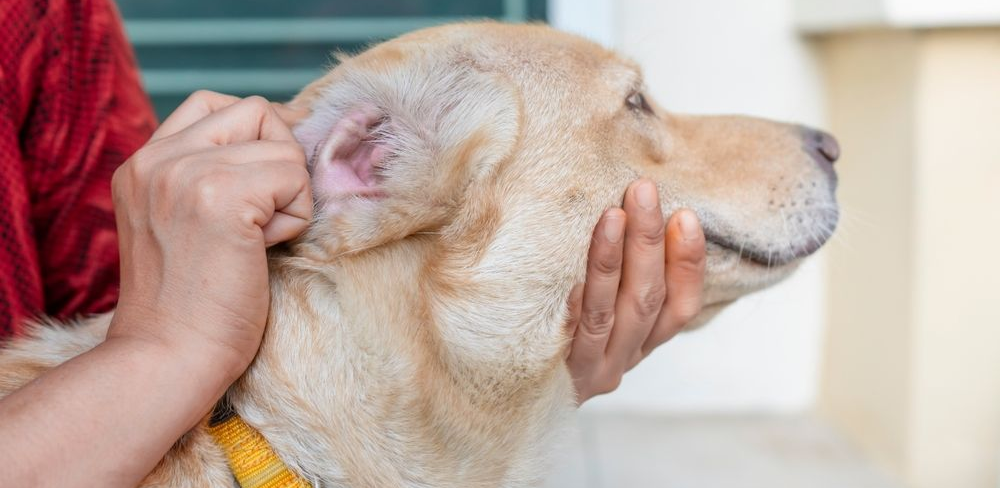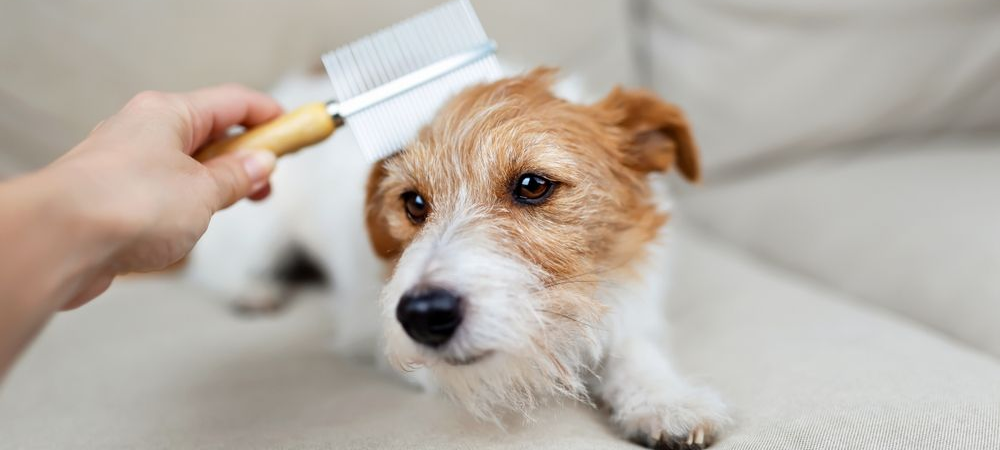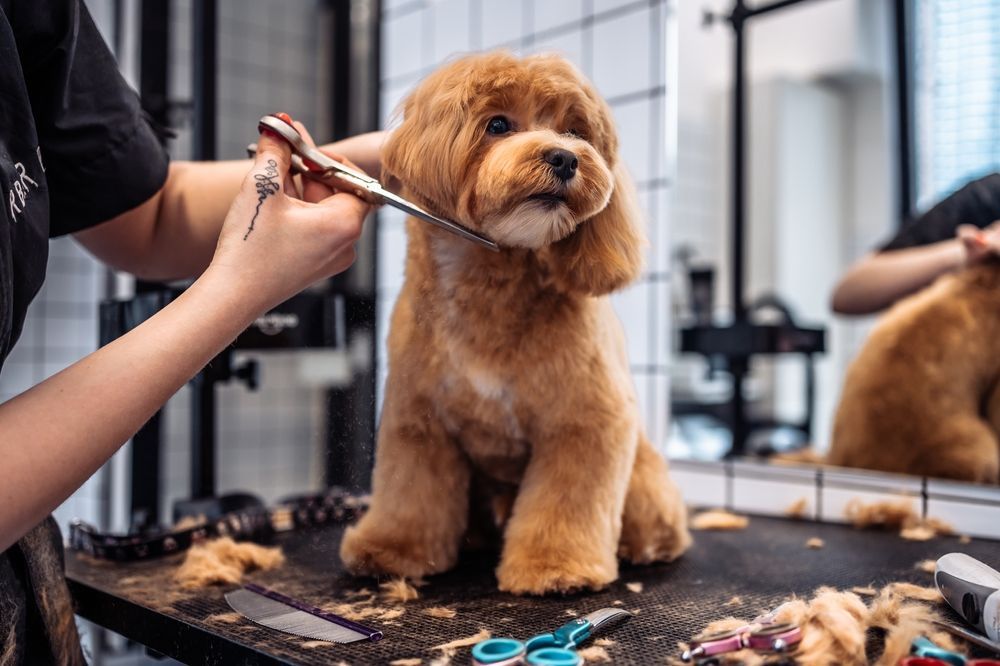How to Check for Fleas on a Dog During Grooming
Your dog is happily wagging its tail as you get the brush ready. But beneath that fur, something tiny could be making them miserable, and you might not even see it at first. Fleas are stealthy, fast, and persistent. They don’t just cause itching; they can lead to skin infections, allergies, and even transmit diseases. That’s why grooming time is more than a beauty session, it’s your first line of defense.
Whether you’re grooming at home or using
Mobile Dog Grooming services, learning how to spot fleas early can save your dog from weeks of discomfort. In this guide, you’ll learn the signs of fleas on dogs, how to do a proper dog flea inspection, and flea prevention tips that actually work.
Why Grooming is the Perfect Time for Flea Checks

Grooming sessions are one of the few times when you have complete access to your dog’s skin and coat. Most dogs tolerate brushing and combing well, giving you the opportunity to inspect areas you wouldn’t normally see. Fleas tend to hide in warm, dark spots where your dog can’t easily scratch, so simply watching your dog during the day may not reveal them.
During grooming, you can part the hair, examine the skin closely, and notice small changes like redness, bumps, or specks of flea dirt. This makes it much easier to detect an infestation early, before the fleas multiply and spread to your home. The earlier you catch them, the easier and cheaper it is to treat your dog, and the less discomfort they have to endure.
Step-by-Step Guide: How to Check for Fleas on a Dog

1. Gather the Right Tools
Before you start, prepare everything you’ll need so you can work efficiently without making your dog anxious. The most important tool is a fine-tooth flea comb, which has closely spaced metal teeth that trap fleas, eggs, and dirt. Good lighting is essential; a bright desk lamp or a headlamp will help you see better, especially if your dog has a dark coat.
Spread a white towel or sheet on your work surface, it will make it easier to spot anything that falls from your dog’s coat. Keep a bowl of warm soapy water nearby to drop in any fleas you catch; the soap breaks the surface tension and kills them instantly.
2. Focus on High-Risk Flea Zones
Fleas are not evenly distributed over your dog’s body. They prefer places that are warm, protected, and harder for your dog to reach when scratching. Start your inspection at the base of the tail, as this is a common hiding spot. Move to the back of the neck and under the collar area, then check behind the ears. The belly, inner thighs, and groin are also prime locations because they are warm and have less fur, making it easier for fleas to feed.
Work slowly, parting the fur with your fingers or a comb so you can see the skin directly. If your dog has long hair, take your time, fleas can hide deep near the roots of the fur.
3. Use the Flea Comb Effectively
When using the flea comb, start at the head and work toward the tail, moving in small sections. Press the comb gently against the skin and pull it through the fur, keeping the teeth close to the skin where fleas are most likely to be. After each stroke, check the comb for live fleas or flea dirt. Tap the comb against your white towel to dislodge anything you’ve caught.
Flea dirt looks like tiny black or dark brown specks, but if you place it on a damp tissue and it turns reddish-brown, it’s dried blood, a sure sign of fleas. Live fleas will be small, flat, and quick-moving.
4. Recognize the Signs of Fleas on Dogs
Even if you don’t see a flea, your dog’s behavior and skin condition can reveal an infestation. Watch for constant scratching, chewing, or licking at certain spots. Fleas cause irritation and itching, which can lead to red, inflamed patches on the skin. In severe cases, you may notice hair loss or small scabs from excessive scratching. Tiny red bumps, especially on the belly or inner thighs, can also indicate flea bites.
Flea Prevention During Grooming
Once you’ve checked for fleas, grooming becomes the perfect time to apply prevention methods. Using a vet-approved flea shampoo that not only helps kill any fleas but also
keeps your dog coat shiny currently on your dog. These shampoos often contain ingredients that target both adult fleas and larvae, breaking the life cycle.
Topical treatments, such as spot-on solutions applied between the shoulder blades, can be highly effective in preventing new infestations. Oral medications are another option and may provide month-long protection. Always follow your veterinarian’s guidance on which product is best for your dog’s age, weight, and health condition.
In addition to treating your dog, clean their environment. Wash their bedding in hot water weekly, vacuum carpets and upholstery regularly, and remember that fleas can live in cracks and crevices, so focus on baseboards and under furniture as well.
Seasonal Flea Prevention Tips
Fleas can be a problem all year round, but they’re especially active during warmer months. In spring and summer, increase the frequency of your inspections and grooming sessions. During autumn, continue treatments even if the weather cools down, fleas can survive indoors where it’s warm.
In winter, many pet owners make the mistake of stopping flea prevention altogether, thinking the cold will kill them. However, fleas can thrive in heated homes, so it’s important to maintain your prevention routine year-round.
Natural Flea Control Options
For those who prefer to minimize chemical use, there are natural approaches that can help, although they may not be as effective for heavy infestations. A diluted apple cider vinegar spray can make your dog’s coat less appealing to fleas. Some owners sprinkle food-grade diatomaceous earth in pet bedding or carpets; it works by dehydrating insects, but it must be used carefully and never applied directly to your dog without veterinary guidance.
Regular grooming alone can disrupt the flea life cycle by removing adults, eggs, and larvae before they multiply. However, in most cases, combining natural methods with vet-approved treatments provides the best protection.
When to See a Vet or Professional Groomer
If you find multiple fleas or notice that your dog’s skin is irritated or infected, professional help is recommended. A veterinarian can prescribe stronger treatments and check for flea-related health issues such as anemia or allergic dermatitis.
Professional groomers are also experienced in handling flea infestations and may use specialized shampoos and equipment to remove fleas more effectively than you could at home. You can consult them about
how often you should groom your dog, they can better advise you on follow-up care and prevention.
Common Mistakes to Avoid During Flea Checks
One of the biggest mistakes is waiting too long to act. Fleas reproduce quickly, and even a small delay can result in a full-blown infestation. Another error is focusing only on the dog and ignoring the environment. Fleas spend most of their life cycle off the host, hiding in carpets, bedding, and furniture.
Using products meant for cats on dogs is dangerous, as some ingredients are toxic to canines. Finally, don’t stop treatments too soon, even after the visible fleas are gone, eggs and larvae may still be present. Continuing prevention ensures they won’t come back.
Quick Daily Flea Checks
Even outside of grooming days, make flea inspections part of your daily routine. As you pet your dog, feel for bumps or rough patches in the skin. Take a quick look at their belly and behind the ears. These small daily habits make it much easier to catch fleas before they spread.
Conclusion
Spotting fleas on a dog early can make all the difference in preventing discomfort, illness, and infestations. Grooming is the perfect opportunity to check your dog’s skin, remove any fleas you find, and apply prevention measures that keep them away for good.
By making flea inspections a regular habit, maintaining year-round prevention, and addressing issues quickly, you protect both your dog’s comfort and your home’s cleanliness. Go ahead and
book a grooming session for your furry friend, stay consistent, and your dog will stay happy, healthy, and flea-free.
FAQs About Fleas on Dogs
What kills fleas on dogs immediately?
Fast-acting flea shampoos or sprays containing ingredients like nitenpyram can kill adult fleas within hours. Oral medications prescribed by a vet can also start working within 30 minutes, providing rapid relief.
Will groomers cut dogs' hair if they have fleas?
Professional groomers can still groom a dog with fleas, but they may take extra precautions. Some salons require flea treatment before grooming or will use a flea bath during the session. Policies vary, so it’s best to check ahead of time.
What shampoo kills fleas?
Shampoos containing pyrethrin, permethrin, or other vet-approved flea-killing ingredients are most effective. Always choose a product made for dogs and follow the instructions carefully to avoid irritation.
Will dogs lick if they have fleas?
Yes. Flea bites are itchy and irritating, so dogs often lick or chew at the affected areas, especially on their legs, belly, and tail base. Excessive licking can lead to skin infections if not treated.
How often should I bathe my dog to prevent fleas?
Bathing your dog every 2–4 weeks with a gentle, flea-preventive shampoo can help. However, frequent bathing should be balanced with your dog’s skin health needs, as over-bathing can cause dryness. Regular brushing between baths also helps remove fleas and dirt.


